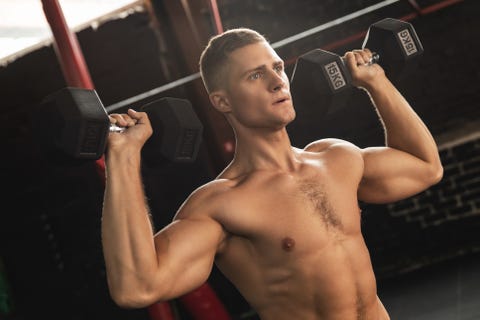

No matter how much weight you’re lifting, you’re going to need strong, stable shoulders to help support the load.
If you struggle with your shoulders — or if you just want to know some more about them — it pays to see how everything’s connected. Read on to learn more about the surprisingly complex system that supports our arms, then use the 5 move warmup set to keep your shoulders healthy and strong.
Degrees of Freedom
From the outside, the shoulder looks like a simple joint —but it’s actually one of the most complicated joints in the body.

The glenohumeral joint (where the arm attaches to the axial skeleton, or the central part of your body) is a shallow ball and socket joint with more degrees of freedom (the ability to move in multiple planes of movement) than most joints.
Due to all that mobility and a shallow physical connection to the scapula, it relies heavily on multiple other structures —including muscles — to stabilize any arm movement.
Shoulder Musculature 101
When people think of muscles of the shoulder they usually think of the rotator cuff, which consists of four parts: the supraspinatus, infraspinatus, teres minor and subscapularis. But there’s a lot more going on in this part of the body.
Technically, the shoulder is comprised of three bones; the scapula (shoulder blade), clavical (collar bone) and humerus (arm bone). These bones move together thanks to a series of muscles, capsules and ligaments that connect and stabilize all the moving parts.

Because of the number of muscles that attach to the scapula (17 to be exact), you need to make sure your exercise routine targets all of them. not just the big ones.
If any one of these 17 muscles is weak, it can affect optimal shoulder mechanics (also known as scapulohumeral rhythm), making the area vulnerable to injury, especially during heavy overhead lifting. The heavier the weights, the more stable your shoulders need to be — so give them some extra attention.
The Shoulder Prep Set
Try these 5 moves to make sure your shoulders are strong and prepared to power you through your next upper body session. For exercises 1 through 4, start with small 2 to 5-lb weights and increase resistance when 2 to 3 sets of 15 repetitions becomes easy.
Prone Ts
This exercise targets the middle traps, one of the muscles responsible for scapular retraction (bringing your shoulder blades back behind you) and helping to rotate the shoulder blade during overhead arm movement.
Do it: Lay on your stomach or with your torso at a 45-degree angle leaning over an exercise ball. With both arms out to the side like the letter “T,” bring arms straight back behind you, lifting from between the shoulder blades while keeping the shoulders from hunching.
Prone Ys
The lower traps are incredibly important for shoulder stability and overhead arm movement and, far too often, these muscles are shockingly weak. The lower traps help to bring the shoulder blades back and down to prevent forward, rounded shoulder posture. Weak lower traps can lead to impingement and pain in the shoulder with overhead movement, so make sure you prioritize this move next time you’re at the gym.
Do it: Assume the same position as you did for the “Prone Ts” but make sure arms lift overhead like you’re forming the letter “Y”. Try not to compensate by lifting from anywhere else in your body, and keep your shoulder blades pinned down and back while you perform these.
Side Lying External Rotation
This exercise directly targets several of the rotator cuff muscles. Because of the shape of the bones and the mechanics of the shoulder joint, external rotation is a critical movement needed to elevate the arm overhead.
Do it: Lay on your side with a pillow or yoga block under your head and a small towel rolled between your elbow and your ribs. Keep your elbow bent to 90-degrees as you gently rotate the hand up towards the ceiling. Your shoulder blades should maintain the down and back position while performing this movement.
Side Lying Abduction
This exercise targets the supraspinatus and deltoid muscles, important muscles for shoulder elevation.
Do it: Start lying on your side like the previous exercise. However, for this one, start with your arm straight down your side with the thumb oriented upwards. Gently lift the arm up in the coronal plane (a straight line from your hip up to vertical) until you’ve achieved 90-degrees of abduction (a 90-degree angle between your torso and your arm). Gently lower back to the starting position, staying in control of the movement.
Planks with Protraction
Planks target many muscles in the body and are a great strengthening exercise for many reasons, and in this case, they’re targeting the serratus anterior (SA). The SA is one of the larger shoulder muscles. It helps stabilize the shoulder blade on the thorax (or ribs) and is another muscle that is critical for pain-free upward arm rotation.
Do it: Place yourself in a “plank” position — facing the floor with core drawn in, hands and toes in contact with the floor. Keep your spine neutral and eyes down as you protract the shoulders by letting shoulder blades move away from each other behind you like you’re trying to push the floor away. Hold this position for 30 to 90 seconds.
If needed, there are many ways to modify a plank. Try resting on your forearms if you have wrist pain (seen above in the video) or starting with a modified plank at a 45-degree angle using a stable surface.
Source: Read Full Article